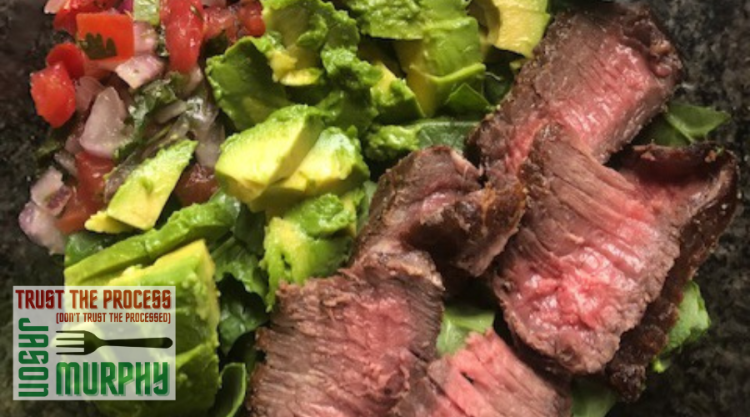
Local fitness enthusiast Jason Murphy remakes favorite meals of his youth into healthy dishes. See the full list of his recipes at www.mysaline.com/jason-murphy.
As a kid, I missed no opportunity to snarf down any junk food I could get my Cheetos-dust-and-Hostess-cupcake-icing-covered little mitts on. A two-liter of Coca-Cola was also required to wash it down. No wonder my face looks like I’ve had an allergic reaction to bee stings in all my childhood photos. If you were the same, you no doubt heard “You are what you eat” in a disapproving voice from a parent.
I did not give it even a second thought. It was summer, I was bored out of my mind, and what kid isn’t going to destroy a pantry full of junk food when left to their own devices? Health, weight, or what might be lurking in all that stuff that could barely be called food was not even a consideration back then. I just chalked it up to a quota of annoying clichés all parents have to say in order to hit their daily total.
I mean, if I wasn’t supposed to eat it, why did they keep buying it? And if it was so bad, why did all the commercials for it have kids looking happy and healthy play during my He-Man cartoons? Sadly, knowledge has replaced He-Man episodes in my brain, and I now understand that once annoying saying doesn’t really go far enough. Yes, you are what you eat. But even as important, you are what your food eats.
Why is it that big corporation corn fed beef is so much cheaper than grass fed and grass finished beef? It’s simple, really. The feed those cows are forced to eat is designed to get them as big and fat as possible, letting them produce more meat, and volume equals profit. But, when you eat that beef, do you think all those side effects of that feed magically disappear? Nope. It still keeps on ticking, and the same fattening process works on you as well. Don’t believe me? Just go sit in a parking lot of a steakhouse and watch people leave. Then ask yourself how many of them you could sit next to on a 6 hour airplane flight..
If you eat red meat as rarely as I do, it’s not going to amount to much eating grain fed instead of grass fed. However, the average American eats red meat much more often, and that will add up. The main difference is omega-6 fats to omega-3 fats. Grain fed beef is full of inflammatory omega-6 fats, because their food is made from soybean oils, corn, and other fillers that would take too long to get into here. Grass fed beef has more omega-3 fats. The average American diet is already way overloaded on omega-6 and not near enough omega-3 fats. One way to counter that is to lower your red meat intake, and when you do have it, find a source for pasture raised cows living like nature intended.
I recently tried a company called Cooks Venture that sells pasture raised chickens from here in state, and pasture raised grass-only cows from New Zealand. They have a $160 pick-and-choose box that ships to your door, and there is no monthly subscription required. I have already used their chicken sold at Whole Foods, and the top sirloin steaks were top quality.
If you want a steak that fits a healthy lifestyle, going out to eat is out of the question. You have to take matters into your own hands. Take the totals of a steak salad from Texas Roadhouse: 1,340 calories, 103 grams fat, 2,870 mg sodium, 42 grams carbs, and 21 grams of sugar. Take a second and read that again, let it sink in. That’s a freaking salad. If those numbers don’t set off alarm bells in your brain (and heart and liver), then you should stop reading these articles. It’s not for you.
If it did make your eyes go wide, then get yourself some grassfed pasture raised top sirloin, use the Alton Brown reverse sear method, and you will have perfect steak every time. Some people only want a steak on the grill, but who wants to stand over something the temp of the business end of an F-14 in this heat? This method also makes the best ever day after cold sliced steak for salads that your formerly grubby cheese dust hands have ever got ahold of in your life.
It’s so easy to do, I only needed pictures of the finished product here, although I do modify it a bit from how he does it. Give this a try for a steak dinner or leftover salad, and you will never go to a steakhouse again, or get stuck in the door trying to leave at the same time as someone else.
Alton Brown Reverse Sear steak method (with minor alts)
Ingredients:
- 4 Grass fed Sirloin steaks 6 to 8 oz
- 2 cloves garlic, smashed but whole
- 2 tsp sea salt
- 2 tsp avocado oil
- Black pepper to taste
Instructions:
Pat the steaks dry with paper towels. Smash the garlic cloves with a butcher knife, remove the paper, then rub the steaks down on both sides with the garlic. Season the steak on both sides with the salt and place on a wire rack set inside a rimmed sheet pan.
Refrigerate uncovered for 12 – 24 hours. Make sure you clear out an empty shelf for no cross contamination.
When it is time to cook, set the steaks out to come to room temp for 30 minutes.
Heat your oven to 200 degrees and roast the steaks on the same wire rack and sheet pan until it hits 120 degrees to 125 degrees. You will need a probe thermometer to be sure you don’t overcook.
Going by time, it can be anywhere from 40 minutes to an hour. Once it hits temp, pull the steaks and rest uncovered for 10 minutes.
Get a 12 inch cast iron skillet rocket hot – at least 500 degrees up to 600.
Rub the steaks with the avocado oil and cook 1 minute per side. Move the steaks to a clean rack to rest for 5 minutes.
Hit both sides with fresh ground pepper to taste and enjoy. Chill any leftovers and slice thin for the best salads you have ever had.


See the list of all Jason Murphy’s recipes at www.mysaline.com/jason-murphy.


